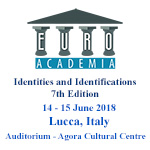Euroacademia Conferences
 Europe Inside-Out: Europe and Europeanness Exposed to Plural Observers (9th Edition) April 24 - 25, 2020
Europe Inside-Out: Europe and Europeanness Exposed to Plural Observers (9th Edition) April 24 - 25, 2020 Identities and Identifications: Politicized Uses of Collective Identities (9th Edition) June 12 - 13, 2020
Identities and Identifications: Politicized Uses of Collective Identities (9th Edition) June 12 - 13, 2020 8th Forum of Critical Studies: Asking Big Questions Again January 24 - 25, 2020
8th Forum of Critical Studies: Asking Big Questions Again January 24 - 25, 2020 Re-Inventing Eastern Europe (7th Edition) December 13 - 14, 2019
Re-Inventing Eastern Europe (7th Edition) December 13 - 14, 2019 The European Union and the Politicization of Europe (8th Edition) October 25 - 26, 2019
The European Union and the Politicization of Europe (8th Edition) October 25 - 26, 2019 Identities and Identifications: Politicized Uses of Collective Identities (8th Edition) June 28 - 29, 2019
Identities and Identifications: Politicized Uses of Collective Identities (8th Edition) June 28 - 29, 2019 The European Union and the Politicization of Europe (7th Edition) January 25 - 26, 2019
The European Union and the Politicization of Europe (7th Edition) January 25 - 26, 2019 7th Forum of Critical Studies: Asking Big Questions Again November 23 - 24, 2018
7th Forum of Critical Studies: Asking Big Questions Again November 23 - 24, 2018 Europe Inside-Out: Europe and Europeanness Exposed to Plural Observers (8th Edition) September 28 - 30, 2018
Europe Inside-Out: Europe and Europeanness Exposed to Plural Observers (8th Edition) September 28 - 30, 2018 Identities and Identifications: Politicized Uses of Collective Identities (7th Edition) June 14 - 15, 2018
Identities and Identifications: Politicized Uses of Collective Identities (7th Edition) June 14 - 15, 2018
Papers
Between the Universal and the Particular: Europe and the Ethical Commitment of Stefan Zweig
This paper will argue that, in order to make the most out of Zweig’s commitment, we have to change the way we approach his legacy. That is to say, instead of trying to convert his ideas into a political discourse, we should approach them from the perspective of their ethical value. Therefore, behind Zweig’s ‘Europe’, we will find a set of notions and principles—individualism, freedom, difference/diversity, pacifism, humanism, empathy, cosmopolitanism...—that go beyond Europe itself to form a Weltanschauung that may helps us figure out both our lives in common and as individuals.Europe Is Elsewhere: Voices from the Edge of Empire
Emerging as a highly contested notion, Europe, on the one hand, is conceived as the agent of ‘Empire’ and, on the other, as the last and most muscular bulwark against it—or it is even employed in both senses simultaneously. My paper will analyze these dynamics of identity construction by exploring common themes among the voices from the colonialized edges of ‘Empire,’ such as Daniela Dahn, Emir Kusturica, Pankraj Mishra, Dipesh Chakrabarty and Vasant Kaiwar.The Interview between Identity and Performance: A Case Study – Heiner Müller – The “Artist of the Interview”
The Müller-Kluge video-interviews, the only situation in which Müller answered to private questions in public, offer us a very interesting case of study concerning the identity of the artist between private subject and persona.Art Spaces and Cultural Production in Post-Reform China: Evidence from the Case of Shenzhen
This research aims at understanding how the quantitative growth of art spaces is related to the current transition in the economic structure of the city, by analyzing the dynamic pattern of their diffusion in relation to the expansion of the tertiary sector of the local economy. Moreover, this study will employ in depth interviews with selected stakeholders to provide a better understanding of their curatorial and artistic approaches.Representing Home? City Museums and Concepts of Identity
Based upon the assumption that identity is not ready-made, but rather the outcome of a dialogical, participative process, I regard city museums as burning glasses of urban identity, as materialized belonging within social, physical and historical structures. How does the interaction between (non-) local visitors and the city museum as a retainer of heterogenic regional memory produce collective, and therefore also individual identity?Identity In The Age Of Uncertainty
This paper argues that there is a connection between the phenomenon of World Expositions and the construction of multiple identities. Seville ‘92, the first universal exposition after Osaka ‘70, was promoted as an exceptional opportunity for Spain to realize its longstanding ambition of a ‘bridge between America and Europe.’Narratology of the Exhibition Space in the Context of Displaying Identity
The aim of the paper is to provide specific example and reflect on the 19th Century exhibition of Danish national art, established by Niels Laurits Hoyen, which played a crucial role in the process of redefinition the national identity and at the same time creation the canon of Danish national art.Painting and Place-Making in A. Diamantis ‘The Planters’
Approaching painting as cultural medium and as process, the paper adopts WJT Mitchell’s lens whereby interest is directed not just to what a painting is or means but to what it does . The paper addresses the theme of a ‘return to the soil’, in relation to the local context of growing anti-colonialism and within the wider European framework of rising nationalisms in the 1930s.Reconstructing Identity in ”Layers” (2010)
Starting from a Contemporary dance piece, ”Layers”, a solo work by the Romanian choreographer Cristina Lilienfeld, we will interrogate the relation individual-society, discussing the cyclic process of building identity which consists, in the context of the presented performance, of the following phases: construction, deconstruction, re-construction.‘Art Brut’ and ‘Outsider Art’ – Consisting ‘Heterotopia’ of the Art World?
Categories as ‘Art Brut’ or ‘Outsider art’ are common in the contemporary art world as well as in art historiography. They aim at the work of artists whose personal backgrounds can be located in such ‘heterotopian’ places. These theoretical terms seem to mirror directly social hierarchic structures and refer to the construction of social identities and identifications.




